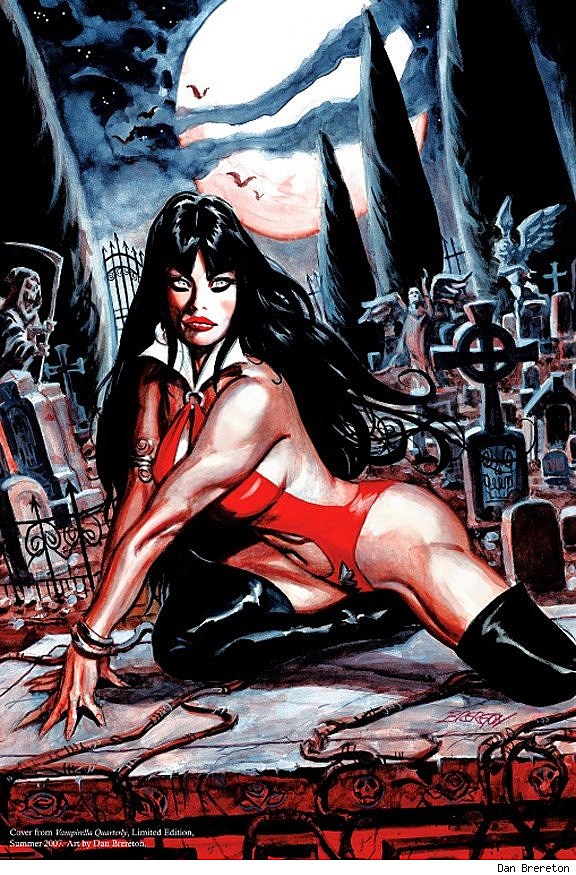![Modern Horror, Sex and Death: Dynamite’s ‘The Art of Vampirella’ [Review]](http://townsquare.media/site/622/files/2013/01/stevenscover-1357187516.jpg?w=980&q=75)
Modern Horror, Sex and Death: Dynamite’s ‘The Art of Vampirella’ [Review]
 Only in comics would you get a character like Vampirella in such a prominent role in the medium's history. Vampirella is arguably, with Wonder Woman and Red Sonja, one of the most iconic female characters in comics. Which is somewhat problematic given that she's meant as a mashup of Uncle Creepy and Elvira -- generally speaking, kind of a sordid mix from which iconic characters grow. In a lot of ways, she's one of the purer manifestations of real old school objectification-of-women-on-comic-covers. There's that. But then on the other side, Vampirella also stands for something else: she is pretty much right on the crossroads of sex/death horror comics. There was a wave of fantastic Alberto Breccia-influenced artists who found homes within the pages of Vampirella comics in the 1970s, artists who did things with the page that even now would be classed as completely mind blowing.
Only in comics would you get a character like Vampirella in such a prominent role in the medium's history. Vampirella is arguably, with Wonder Woman and Red Sonja, one of the most iconic female characters in comics. Which is somewhat problematic given that she's meant as a mashup of Uncle Creepy and Elvira -- generally speaking, kind of a sordid mix from which iconic characters grow. In a lot of ways, she's one of the purer manifestations of real old school objectification-of-women-on-comic-covers. There's that. But then on the other side, Vampirella also stands for something else: she is pretty much right on the crossroads of sex/death horror comics. There was a wave of fantastic Alberto Breccia-influenced artists who found homes within the pages of Vampirella comics in the 1970s, artists who did things with the page that even now would be classed as completely mind blowing.
My interest in Vampirella is her role as a symbol of just-outside-the-mainstream artists from around the world completely going wild artistically. When I first became aware of the fact that there was a Vampirella art book from Dynamite, I was pretty excited about it. Right away, my head was filled with images of José Gonzalez, Gonzalo Mayo, Fernando Fernandez, Jeffrey Catherine Jones, Esteban Maroto, Frank Frazetta, and Sanjulian. For me, the art of those old Vampirella magazines is one of my key touchstones as an artist and represents the type of comics I would like to see more of. So I was a little shocked when I got the art book and discovered that it's actually all covers -- and not the old, amazing covers from the Warren Comics days, but mostly covers from the run of "bad girl" Vampirella comics from the '90s to the 2000s. The book turned from something that I was rabidly anticipating to something that I was initially unsure of what to do with.
But after getting a chance to go through The Art of Vampirella --which includes work by modern stylists like Dave Stevens, Jae Lee, Amanda Conner, Mike Mignola, Phil Noto, Michael Golden, Dan Brereton, Bruce Timm, Arthur Suydam, Adam Hughes, Joe Jusko, Jim Lee and more -- I have to say in the end I am really pleased to own it.
WARNING: The following contains images that may be considered not safe for work.

For most of the last, say, 30 years of Vampirella comics, most of the remaining merit in the character had been segregated off into the realm of cover illustration. Dynamite has been having a go at revitalizing the character herself in various new narratives since they began publishing new Vampi comics in 2011, but for many years prior the interior art was definitely not as progressive and challenging as it was in the 1970s. However, many of the modern covers collected in Dynamite's art book are playing with the same dark magic of the originals. What is really interesting to me about this collection is that I think many of the cover artists were coming at the work from the same angle I came at Vampirella originally. You saw those first Frank Frazetta covers and they pulled you into her dark universe. It's fascinating to see -- and you can tell -- the difference in approach between artists who are actively engaging in that kind of dialogue with the old covers and those who approached their own Vampi work as more of a boilerplate T&A thing. As such, I think there is merit here as a study of influence and as sort of an additional lens on the Vampirella legacy.
Additionally, I think there is merit just in terms of having so many artists and styles back to back, all drawing within the same rules and restrictions that make up a proper Vampirella cover. It's fun to see who does what, and how, even within so much that should mostly be the same given the limitations of the subject, there is still an infinity of variations and riffs to behold. With each artist you are getting to see a slightly different incarnation of Vampirella, and I think the net effect of that is a fuller picture of what exactly the character is and what she means to people.
The artists who stand out for me in the collection are Joe Jusko, Arthur Suydam, Jim Silke, Mark Texeira, Michael Golden, and David Finch. Finch, for all of the accessories he threw on Vampirella and how much story comes across in his images. Golden, for both the prominence of his line and the use of white in his coloring. Texeira, for his early '80s movie poster style, which more so than any other artist in the collection casts Vampirella as a creature of the city. Silke, for his channeling of turn of the century illustration techniques. There is also this really whimsical Bill Sienkiewicz cover in the collection that I haven't really figured out one way or the other.
Jusko and Suydam though are the ones of that group whose contributions by themselves justify owning this collection. Jusko is probably the guy in this book who most gets those old Vampirella covers, and his covers end up reading like a cool 1980s extended remix of the tradition started by artists like Sanjulian and Enric. Jusko's covers are also metal as all hell. Blood everywhere, leather jackets, lots of sex, and every image a gothic story unto itself. Great gothic storytelling is the core element behind most of the best Vampirella covers (that and sex), and Jusko is definitely playing with this tradition. His work comes across in a much more primal way than the other artists. I think the most powerful of his covers are the ones which involve rivers and waterfalls of blood around Vampirella. There is something about the power of all of that blood mixed in with the image of the vampire vamp... it is at once hellish, sexual, and dark. This is sex and death turned up to 11.
What's crazy is that if you didn't tell me that the bulk of these Jusko covers were done in the late '90s and early 2000s, I would absolutely have never of guessed it. I think in some ways his covers work as a condemnation of the way that work from the '70s has sort of been tossed aside and forgotten today, because Jusko's work shows us there are lessons in that iconography that many modern artists who are trying to play in these same playgrounds have simply forgotten in their rush to be the next Neil Adams, or Jack Kirby, or Jim Lee.
Arthur Suydam is a different beast entirely. His covers come with insanely strong palettes, and though they are much more modern images than the Jusko covers they still achieve the central mystery that Jusko mainlined for his illustrations. The way Suydam draws Vampirella herself is also subtly different from every other artist I've ever seen draw the character. In Suydam's art she is much more exotic and ethereal; more of the mists. The way Suydam handles skin tone for Vampirella is kind of amazing, too. A lot of colorists will try to relate their colors to one another, but oftentimes in doing so they lose some of that bombastic pop that the work requires. Suydam is a master of these relationships and knows how -- just with his color choices -- to create distance, depth, and complexity that you just don't see enough of in comics.
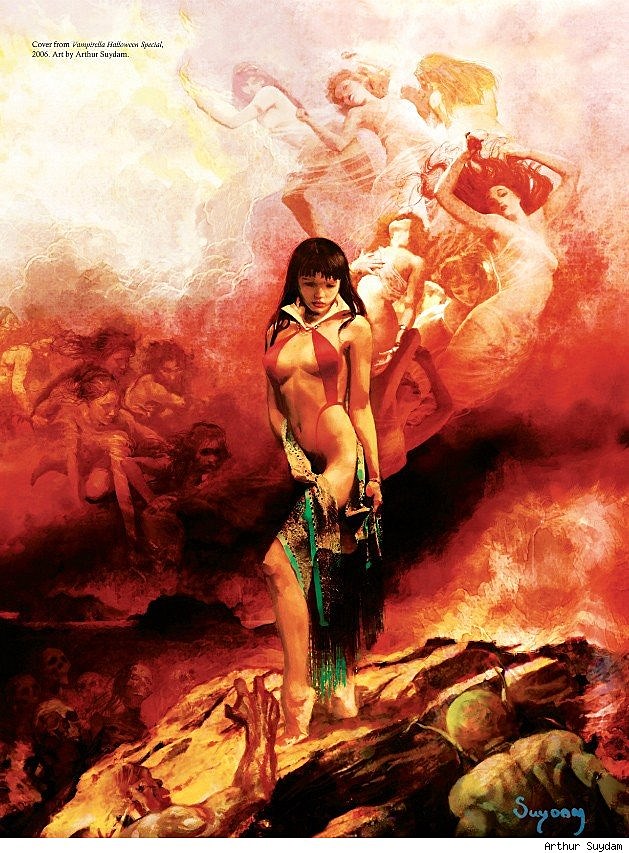
My favorite Vampirella cover in the entire collection is probably the Suydam cover above, where he has Vampirella on top of a mountain and about to be swarmed by demons. She has this green striped coverup that she is undoing (I would assume because she's about to throw down--who knows), and behind her, buried in these apocalyptically orange clouds, are a host of angels watching. And in between these angels and these demons there's death and Vampirella. It is an incredibly dense image, yet somehow effortlessly so. You can look at it for hours and unfold the story it tells in your mind across multiple levels. That is the magic of a great Vampirella cover, and really a great sci-fi/horror cover. We need more of this kind of thing.
In addition to the cover reproductions The Art of Vampirella includes a complete short story drawn and colored by Bruce Timm that CA's Andy Khouri posted and wrote about this past Halloween, as well as several interviews. Naturally Jusko is interviewed, which of course was the most interesting interview for me because he had the most to say about Vampirella's art history (as I said, you can tell he had ingested the magical covers of her past). One of the most prolific Vampi artists of the modern age, Amanda Connor is interviewed as well, and has a whole section of the book devoted to her art.
There's also an interesting interview with Alan Moore where he presages the shift in the depiction of vampires in the modern context. I think if he had known then what we know now about the mainstream pervasiveness of True Blood and Twilight, Moore might have reconsidered his desire to toss aside the castles and bats of the Dracula aesthetic. Contrary to what Moore anticipated, the modernization of the vampire has turned them into a sanitized version of the "sex and death" horror trope that had once inspired so much great art. Now if you want to get your hardcore sex/death image fix, you have to start stalking xenomorph art. But it's still an interesting discussion overall.
Additionally, Kurt Busiek has a huge article in here breaking down Vampirella's continuity -- a task so monumental I almost felt bad for him. That there even is a convoluted Vampirella canon speaks a lot to why the character is so marginalized right now (indeed, why all genre comics are so marginalized right now?). I don't think the strength of Vampirella was ever Vampirella herself, nor her specific adventures. It was her idiom, a kind of avatar of horror/sex/death stories from cutting edge artistic talent, that was the appeal. Even in her solo stories back in the day, I don't think I ever read them with the idea that this was a character who needed an especially long or specific character arc. She was mostly just there so José Gonzalez could draw pretty women in gothic horror settings; the same way that an old Jean Rollin horrror film operates.
That shift in the Vampirella line over the last few decades from one based in imagery and mood to one of the more traditional comic book hero has definitely been a weird one. It would be interesting to see Dynamite try to return the book to its roots but in a modern context. Imagine a new wave of Vampirella horror anthologies with contributions from the new school of expressive cartoonists like Emma Ríos, James Stokoe or Giannis Milogiannis. Something like a more focused and edgy Dark Horse Presents or, perhaps more aptly, a sexy, gothic answer to the whimsical Rocketeer Adventures.
I would definitely recommend The Art of Vampirella to people interested in studying the history of Vampirella in illustration, those looking at artistic progression over a period of time, and those just interested in thinking about the different ways to create iconic covers. But if you are wanting to figure out why the hell someone would even care at all about Vampirella enough to write a lengthy article on an art book dedicated to her, you should also pick up the great Vampirella Archive hardcovers that Dynamite has been putting out, featuring classic comics by José Gonzalez, Richard Corben, Dough Moench, Archie Goodwin, Wally Wood, Frank Frazetta and more, because that stuff... that stuff is the realness.

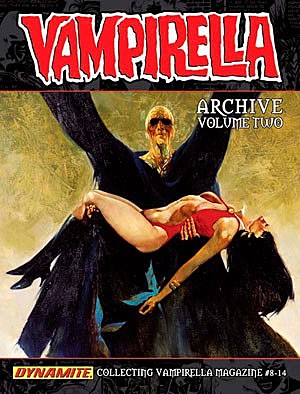
The Art of Vampirella and Vampirella Archives Volumes 1-6 are on sale now from Dynamite Entertainment or finer comics shops and bookstores, and available digitally from ComiXology.
More From ComicsAlliance
![How Conner And Palmiotti Reinvigorated Harley And Reimagined ‘The Jetsons’ [Interview]](http://townsquare.media/site/622/files/2017/03/Harley-Featured.png?w=980&q=75)
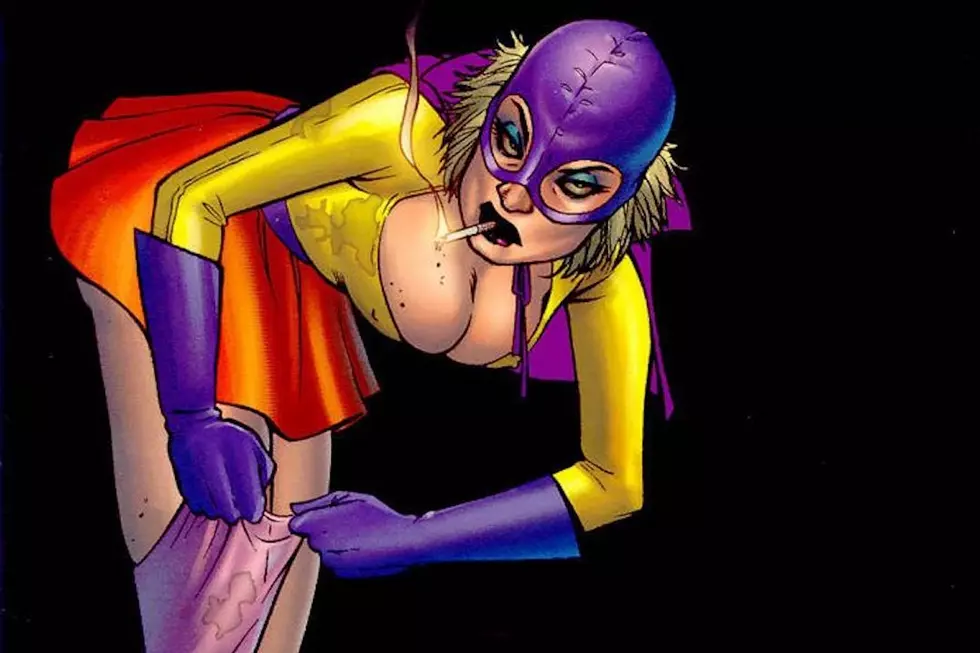
![Kamandi Skips The Con, But Still Has A Weird Time In San Diego In ‘The Kamandi Challenge’ #3 [Exclusive]](http://townsquare.media/site/622/files/2017/03/Kamandi00.jpg?w=980&q=75)
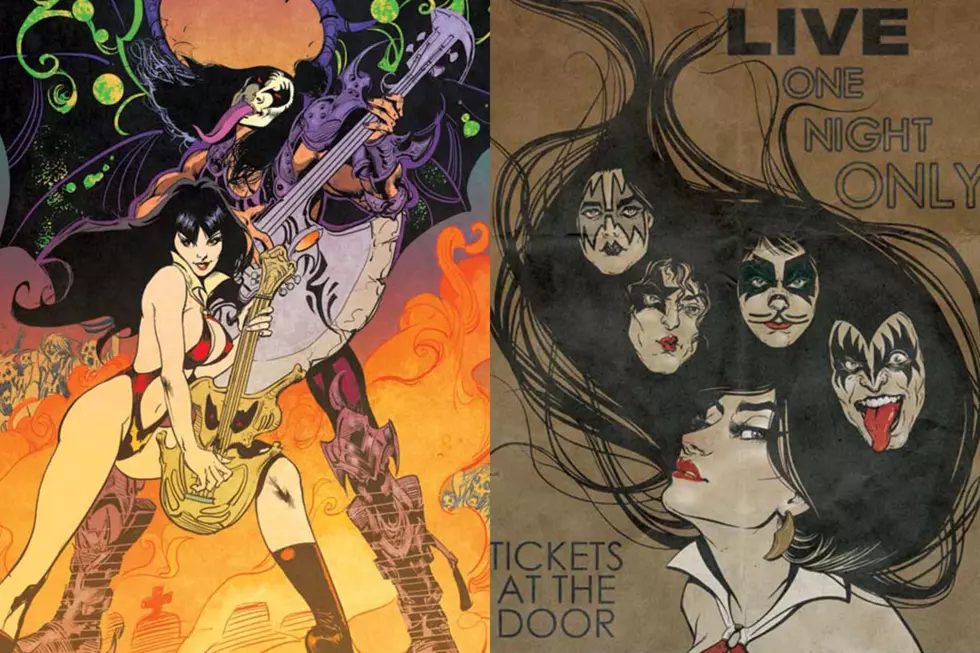


![‘Joker Loves Harley’ Comes To An Explosive End In ‘Harley Quinn’ #13 [Exclusive Preview]](http://townsquare.media/site/622/files/2017/01/HQ00.jpg?w=980&q=75)



